Input interpretation

O_2 oxygen + NaNO_2 sodium nitrite ⟶ NaNO_3 sodium nitrate
Balanced equation
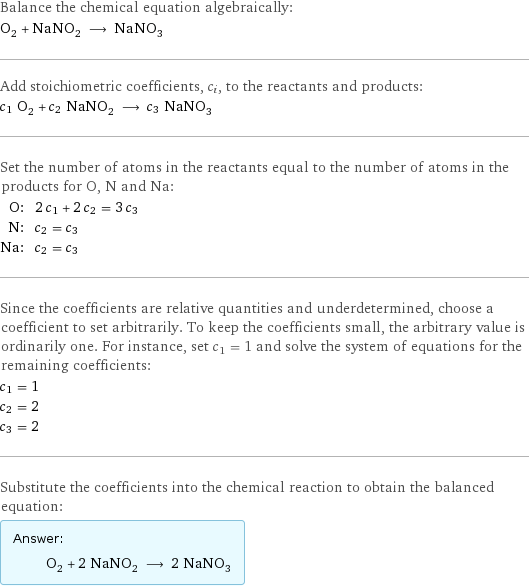
Balance the chemical equation algebraically: O_2 + NaNO_2 ⟶ NaNO_3 Add stoichiometric coefficients, c_i, to the reactants and products: c_1 O_2 + c_2 NaNO_2 ⟶ c_3 NaNO_3 Set the number of atoms in the reactants equal to the number of atoms in the products for O, N and Na: O: | 2 c_1 + 2 c_2 = 3 c_3 N: | c_2 = c_3 Na: | c_2 = c_3 Since the coefficients are relative quantities and underdetermined, choose a coefficient to set arbitrarily. To keep the coefficients small, the arbitrary value is ordinarily one. For instance, set c_1 = 1 and solve the system of equations for the remaining coefficients: c_1 = 1 c_2 = 2 c_3 = 2 Substitute the coefficients into the chemical reaction to obtain the balanced equation: Answer: | | O_2 + 2 NaNO_2 ⟶ 2 NaNO_3
Structures
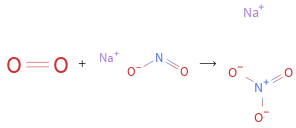
+ ⟶
Names

oxygen + sodium nitrite ⟶ sodium nitrate
Reaction thermodynamics
Enthalpy

| oxygen | sodium nitrite | sodium nitrate molecular enthalpy | 0 kJ/mol | -359 kJ/mol | -467.9 kJ/mol total enthalpy | 0 kJ/mol | -718 kJ/mol | -935.8 kJ/mol | H_initial = -718 kJ/mol | | H_final = -935.8 kJ/mol ΔH_rxn^0 | -935.8 kJ/mol - -718 kJ/mol = -217.8 kJ/mol (exothermic) | |
Gibbs free energy
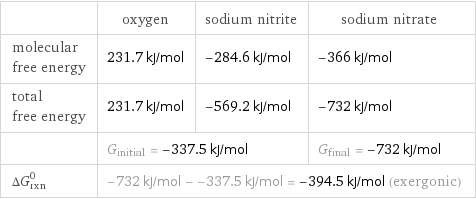
| oxygen | sodium nitrite | sodium nitrate molecular free energy | 231.7 kJ/mol | -284.6 kJ/mol | -366 kJ/mol total free energy | 231.7 kJ/mol | -569.2 kJ/mol | -732 kJ/mol | G_initial = -337.5 kJ/mol | | G_final = -732 kJ/mol ΔG_rxn^0 | -732 kJ/mol - -337.5 kJ/mol = -394.5 kJ/mol (exergonic) | |
Equilibrium constant
![Construct the equilibrium constant, K, expression for: O_2 + NaNO_2 ⟶ NaNO_3 Plan: • Balance the chemical equation. • Determine the stoichiometric numbers. • Assemble the activity expression for each chemical species. • Use the activity expressions to build the equilibrium constant expression. Write the balanced chemical equation: O_2 + 2 NaNO_2 ⟶ 2 NaNO_3 Assign stoichiometric numbers, ν_i, using the stoichiometric coefficients, c_i, from the balanced chemical equation in the following manner: ν_i = -c_i for reactants and ν_i = c_i for products: chemical species | c_i | ν_i O_2 | 1 | -1 NaNO_2 | 2 | -2 NaNO_3 | 2 | 2 Assemble the activity expressions accounting for the state of matter and ν_i: chemical species | c_i | ν_i | activity expression O_2 | 1 | -1 | ([O2])^(-1) NaNO_2 | 2 | -2 | ([NaNO2])^(-2) NaNO_3 | 2 | 2 | ([NaNO3])^2 The equilibrium constant symbol in the concentration basis is: K_c Mulitply the activity expressions to arrive at the K_c expression: Answer: | | K_c = ([O2])^(-1) ([NaNO2])^(-2) ([NaNO3])^2 = ([NaNO3])^2/([O2] ([NaNO2])^2)](../image_source/de9c645ba70eef54dfb9a8ffd800e089.png)
Construct the equilibrium constant, K, expression for: O_2 + NaNO_2 ⟶ NaNO_3 Plan: • Balance the chemical equation. • Determine the stoichiometric numbers. • Assemble the activity expression for each chemical species. • Use the activity expressions to build the equilibrium constant expression. Write the balanced chemical equation: O_2 + 2 NaNO_2 ⟶ 2 NaNO_3 Assign stoichiometric numbers, ν_i, using the stoichiometric coefficients, c_i, from the balanced chemical equation in the following manner: ν_i = -c_i for reactants and ν_i = c_i for products: chemical species | c_i | ν_i O_2 | 1 | -1 NaNO_2 | 2 | -2 NaNO_3 | 2 | 2 Assemble the activity expressions accounting for the state of matter and ν_i: chemical species | c_i | ν_i | activity expression O_2 | 1 | -1 | ([O2])^(-1) NaNO_2 | 2 | -2 | ([NaNO2])^(-2) NaNO_3 | 2 | 2 | ([NaNO3])^2 The equilibrium constant symbol in the concentration basis is: K_c Mulitply the activity expressions to arrive at the K_c expression: Answer: | | K_c = ([O2])^(-1) ([NaNO2])^(-2) ([NaNO3])^2 = ([NaNO3])^2/([O2] ([NaNO2])^2)
Rate of reaction
![Construct the rate of reaction expression for: O_2 + NaNO_2 ⟶ NaNO_3 Plan: • Balance the chemical equation. • Determine the stoichiometric numbers. • Assemble the rate term for each chemical species. • Write the rate of reaction expression. Write the balanced chemical equation: O_2 + 2 NaNO_2 ⟶ 2 NaNO_3 Assign stoichiometric numbers, ν_i, using the stoichiometric coefficients, c_i, from the balanced chemical equation in the following manner: ν_i = -c_i for reactants and ν_i = c_i for products: chemical species | c_i | ν_i O_2 | 1 | -1 NaNO_2 | 2 | -2 NaNO_3 | 2 | 2 The rate term for each chemical species, B_i, is 1/ν_i(Δ[B_i])/(Δt) where [B_i] is the amount concentration and t is time: chemical species | c_i | ν_i | rate term O_2 | 1 | -1 | -(Δ[O2])/(Δt) NaNO_2 | 2 | -2 | -1/2 (Δ[NaNO2])/(Δt) NaNO_3 | 2 | 2 | 1/2 (Δ[NaNO3])/(Δt) (for infinitesimal rate of change, replace Δ with d) Set the rate terms equal to each other to arrive at the rate expression: Answer: | | rate = -(Δ[O2])/(Δt) = -1/2 (Δ[NaNO2])/(Δt) = 1/2 (Δ[NaNO3])/(Δt) (assuming constant volume and no accumulation of intermediates or side products)](../image_source/178e2797c581f8ba0b0f53b7eb4f49ee.png)
Construct the rate of reaction expression for: O_2 + NaNO_2 ⟶ NaNO_3 Plan: • Balance the chemical equation. • Determine the stoichiometric numbers. • Assemble the rate term for each chemical species. • Write the rate of reaction expression. Write the balanced chemical equation: O_2 + 2 NaNO_2 ⟶ 2 NaNO_3 Assign stoichiometric numbers, ν_i, using the stoichiometric coefficients, c_i, from the balanced chemical equation in the following manner: ν_i = -c_i for reactants and ν_i = c_i for products: chemical species | c_i | ν_i O_2 | 1 | -1 NaNO_2 | 2 | -2 NaNO_3 | 2 | 2 The rate term for each chemical species, B_i, is 1/ν_i(Δ[B_i])/(Δt) where [B_i] is the amount concentration and t is time: chemical species | c_i | ν_i | rate term O_2 | 1 | -1 | -(Δ[O2])/(Δt) NaNO_2 | 2 | -2 | -1/2 (Δ[NaNO2])/(Δt) NaNO_3 | 2 | 2 | 1/2 (Δ[NaNO3])/(Δt) (for infinitesimal rate of change, replace Δ with d) Set the rate terms equal to each other to arrive at the rate expression: Answer: | | rate = -(Δ[O2])/(Δt) = -1/2 (Δ[NaNO2])/(Δt) = 1/2 (Δ[NaNO3])/(Δt) (assuming constant volume and no accumulation of intermediates or side products)
Chemical names and formulas
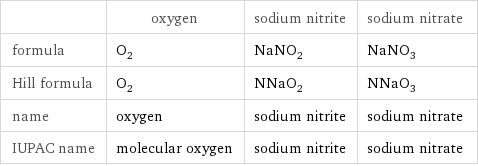
| oxygen | sodium nitrite | sodium nitrate formula | O_2 | NaNO_2 | NaNO_3 Hill formula | O_2 | NNaO_2 | NNaO_3 name | oxygen | sodium nitrite | sodium nitrate IUPAC name | molecular oxygen | sodium nitrite | sodium nitrate
Substance properties
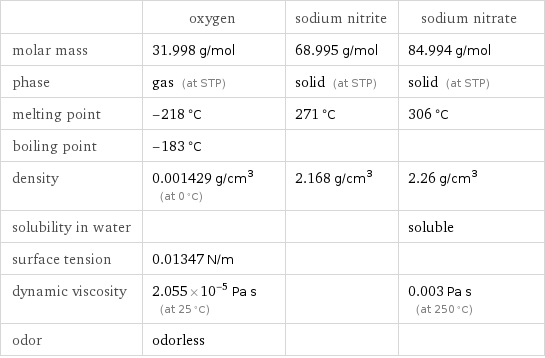
| oxygen | sodium nitrite | sodium nitrate molar mass | 31.998 g/mol | 68.995 g/mol | 84.994 g/mol phase | gas (at STP) | solid (at STP) | solid (at STP) melting point | -218 °C | 271 °C | 306 °C boiling point | -183 °C | | density | 0.001429 g/cm^3 (at 0 °C) | 2.168 g/cm^3 | 2.26 g/cm^3 solubility in water | | | soluble surface tension | 0.01347 N/m | | dynamic viscosity | 2.055×10^-5 Pa s (at 25 °C) | | 0.003 Pa s (at 250 °C) odor | odorless | |
Units
